Think alligators are just a Florida or Louisiana thing? Think again. From the bayous of East Texas to the wetlands along the Gulf Coast, the Lone Star State is home to an estimated 400,000 to 500,000 American alligators — and yes, quite a few live in Texas lakes. Whether you’re kayaking, fishing, or just soaking up the sun by the water, chances are you’ve been closer to a gator than you realize.
But don’t worry — these ancient reptiles aren’t out to get you. In fact, they’ve been sharing space with humans for millennia. Alligators have been around since the time of the dinosaurs, surviving mass extinctions. Today, they continue to thrive in quiet, freshwater areas across East and South Texas, mostly avoiding people unless provoked or fed.
Curious where you might encounter one of these modern-day dinosaurs in the wild? Let’s take a look at the Texas lakes where gators still roam — and what you need to know to enjoy your time outdoors safely.
What Lakes in Texas Have Alligators?
The alligator habitat in Texas covers the eastern border and its lakes and rivers, and the Texas coast and its lakes and rivers. An imaginary arc from Texarkana around to the western edges of Dallas, Austin, San Antonio, Laredo, and down to Brownsville roughly delineates the gator habitat in east and south Texas, kind of following I-35.
Texas lakes near the Cypress, Sabine, and Sulphur Rivers that flow into Louisiana on the east, and 14 major rivers and their tributaries that flow into the Gulf of Mexico have alligators. The regions described above contain these rivers and lakes.
The 14 rivers flowing into the Gulf from the upper to the lower Texas coast are Neches, Neches-Trinity, Trinity, Trinity-San Jacinto, San Jacinto-Brazos, Brazos-Colorado, Colorado-Lavaca, Lavaca, Lavaca-Guadalupe, Guadalupe, San Antonio, San Antonio-Nueces, and the Nueces-Rio Grande.
The lands near the border of Louisiana and closest to the Gulf have the highest alligator population. Another band of land north wraps around this area has alligators, but less of a population. We will discuss some of the major lakes and rivers in Texas where alligators love to wallow, bask, and nest.
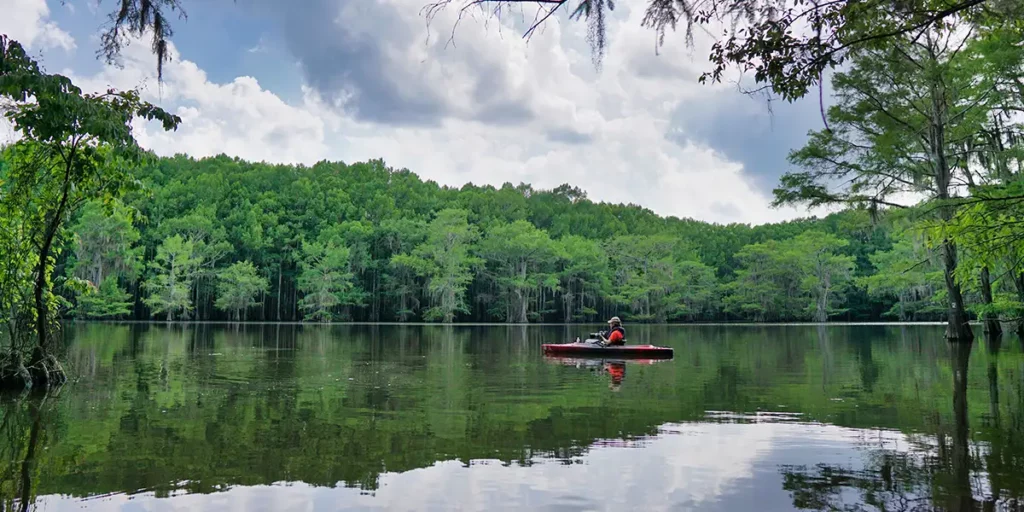
1. Caddo Lake
Located on the Texas and Louisiana state line, Caddo Lake is dense with cypress trees, vast bayous, ponds, canals, and creeks. The total area is 25,400 acres, which make up a pretty big swamp. Caddo Lake is only eight to ten-feet deep on average with a maximum depth of 20-feet and is chock-full of alligator food sources. These conditions make for an ideal alligator habitat. Caddo Lake has one of the largest alligator populations compared to other Texas lakes.

2. Lady Bird Lake
Lady Bird Lake is a trendy lake near Austin, Texas for recreational boating, fishing, and swimming. It is a small lake covering only 469 acres. In 2020, after kayaker Anna Eulo snapped a pic of a gator right before it sank back into the lake, Jonathan Warner, Texas Parks and Wildlife Department alligator program leader, reported, “It’s not common, but I wouldn’t say it’s out of the ordinary, either.”
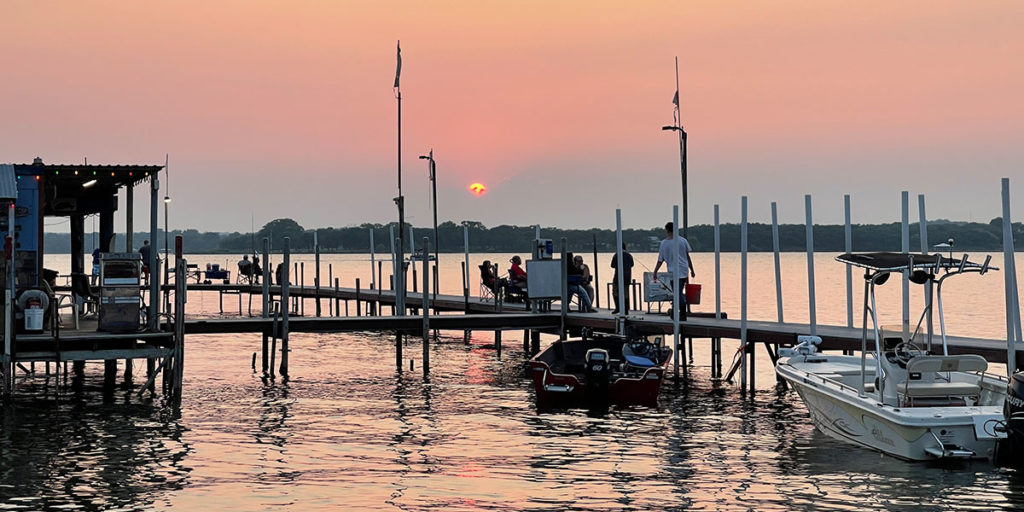
3. Eagle Mountain Lake
Anglers flock to Eagle Mountain Lake to fish for various species of bass, catfish, and crappie, and for fishing sports events. Visitors love this lake for skiing, wakeboarding, and recreational boating. Wildlife photographer Jimmy Martin photographed alligators in Eagle Mountain Lake and the Trinity River In 2021, and reported them to the Ft. Worth Nature Center.
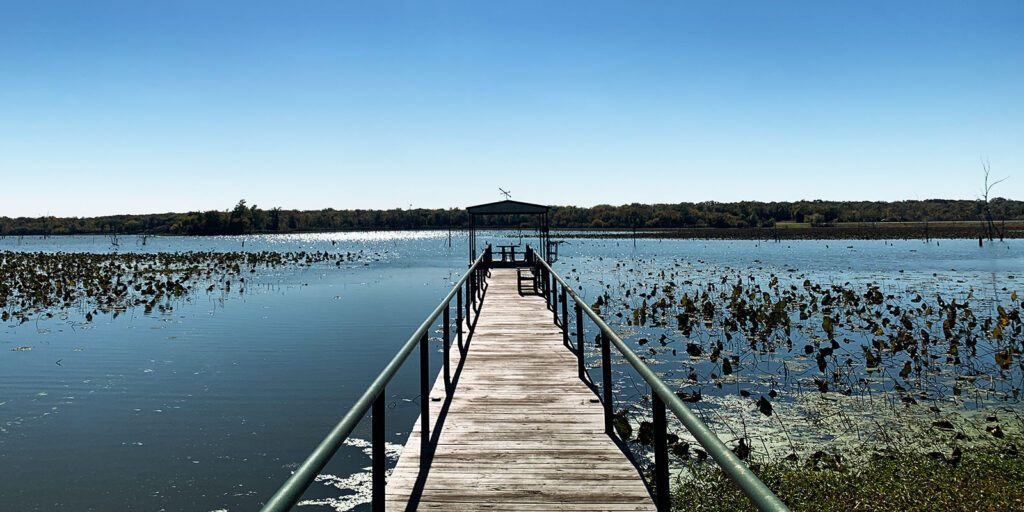
4. Lake Fork
Lake Fork holds 15 of the top 20 Texas State Records for largemouth bass. Anglers know Lake Fork as a premier trophy bass fishing lake. It lies on a major tributary of the Sabine River, and over the last 40 years, Texas Parks and Wildlife has stocked it with largemouth bass, bluegill, catfish, and sunfish. Lake Fork gators take pleasure in Lake Fork’s shallow water coves protected from wind that back up into ponds off of the main lake.
5. Grapevine Lake
Grapevine Lake sits amid several Dallas and Ft. Worth suburbs and is wildly crowded with recreational boaters, anglers, and day trippers. It is a beautiful lake offering its suburban residents unusual experiences and mega attractions like the Great Wolf Lodge. It is uncommon to see gators on Grapevine Lake. The western and northwestern areas of Grapevine Lake are marshy, and that is mainly where gator sightings occur.
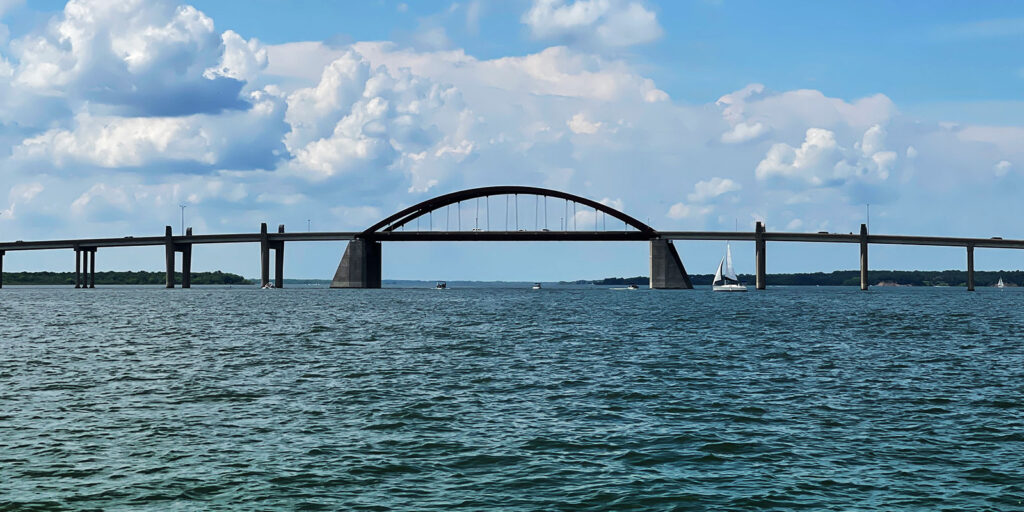
6. Lake Lewisville
Lake Lewisville is a popular lake surrounded by city life. It is popular for biking, camping, hiking, jet-skiing, picnicking, sailboarding, and swimming. People have reported seeing gators crossing roads, and in the streams around Lake Lewisville. The Texas Parks and Wildlife Department estimates that there are a few dozen alligators in Lake Lewisville, plus known populations around it via Sam Kieschnick’s photos, an urban wildlife photographer for Texas Parks and Wildlife.
7. Lake Livingston
Lake Livingston is the second largest lake within the borders of Texas, and popular with anglers and outdoor enthusiasts. Acres of forests and wildlife surround Lake Livingston. Alligators are a part of that wildlife. Lake Livingston is in the part of Texas, close to Louisiana and the Gulf Coast, with the highest population of alligators. Anglers have been reporting large gator sightings for years.
8. Lake Sam Rayburn
Lake Sam Rayburn lies in the part of Texas with an ideal habitat for alligators close to the Louisiana border. It is also extremely rural with only one small town, Lufkin, less those 20 miles to its northwest and barely any housing developments. Anglers and boaters report sightings of large gators on a semi-regular basis.
9. Lake Tawakoni
Lake Tawakoni lies in that area with a large gator population. It is rural, with a few residential communities and mostly surrounded by nature, and supports a perfect gator habitat. There is not sufficient data to estimate gator populations on most lakes, but it is believed that there are about 400 gators living in or at Lake Tawakoni.
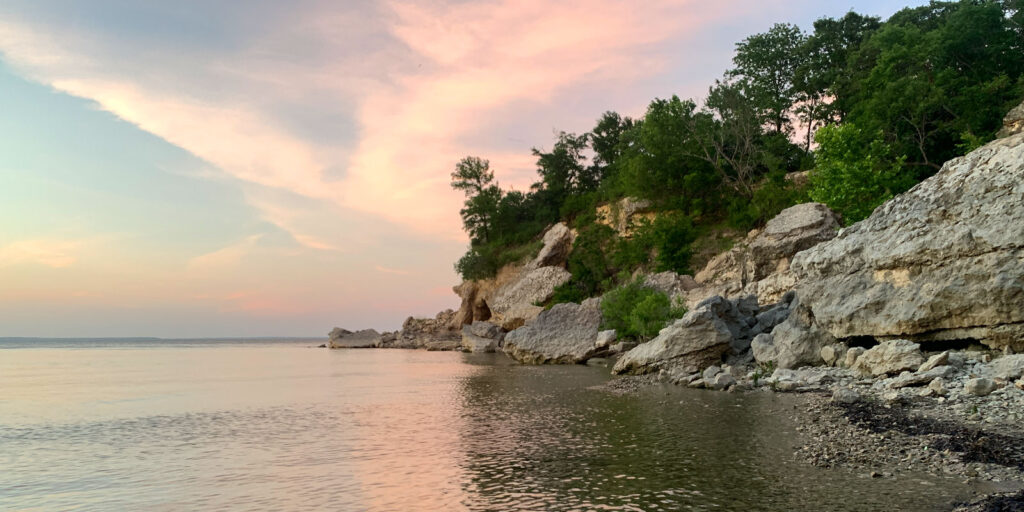
10. Lake Texoma
Lake Texoma lies on the Red River and in the furthest northern region in Texas to support gators. Gators barely make into Oklahoma in the far Arklatex region, then the climate is too cold for them. The gator habitats at Lake Texoma are close to the Hagerman National Wildlife Refuge, the Tishomingo National Wildlife Refuge, Fobb Bottom Wildlife Management Area, and some of the more unpopulated shorelines in Oklahoma. Gator sightings are uncommon at Lake Texoma.
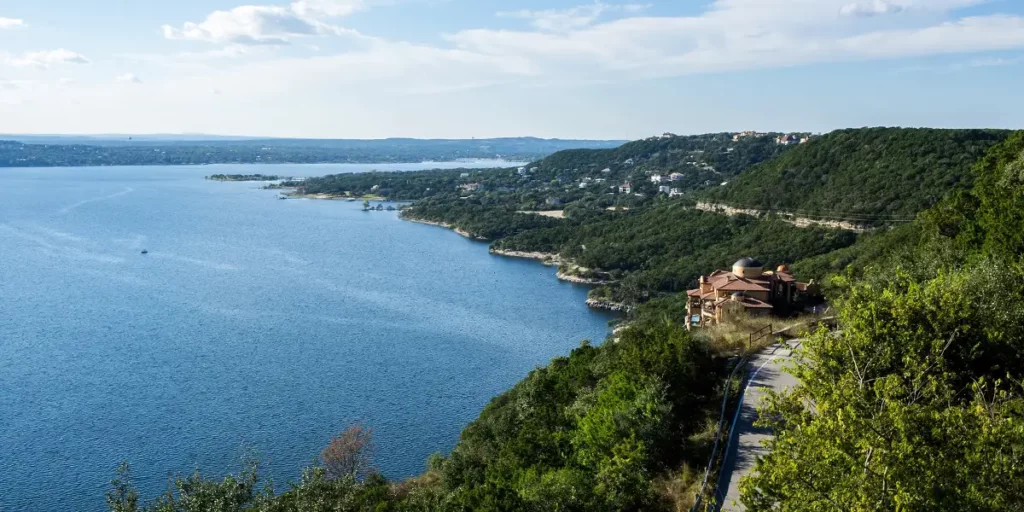
11. Lake Travis
Lake Travis sits in that iffy gator habitat in Texas where it is almost outside of the gator’s natural territory. Its shorelines are highly developed in many areas, but in others, you would never know how close you are to Austin. However, even though gators are known to hang out on the Colorado River, which feeds Lake Travis, wildlife professionals believe there are few gators in Lake Travis. When there is a gator sighting, it is big news.
12. Toledo Bend
Toledo Bend spreads north and south on the southern Texas-Louisiana border. It lies in gator country. There are loads of gators at Toledo Bend, but they love to hang out in the most beautiful, and most remote, areas of the lake. They like to stay to themselves, and unless you are hiking or boating in their habitats, they are not easy to spot even though they are many.
13. Lake Worth
Lake Worth is popular with Ft. Worth residents because it is only minutes from downtown. Lake Worth covers 3,489-acres. Beaches, historic buildings, antique stores, shops, restaurants, art galleries, and more, dot Lake Worth’s shores. Wildlife professionals estimate its gator population is 15 to 25. Residents have reported nuisance gators.
Rivers in Texas with Alligators
The Mexican media reports that U.S. government officials have released giant alligators into the Rio Grande River recently, which did not support gator habitats. You will not find this reported in U.S. media, but the U.S. Border Patrol posted a pic of a giant gator floating down the Rio Grande River on its Facebook Page.
The Border Patrol calls their gator an interri-gator, an investi-gator, and a navi-gator. Newsweek also posted the Border Patrol’s gator pic and called it gator-aid. Hmm, something to ponder…The Brazos River and its tributaries, the Sabine River and its tributaries, and the Trinity River and its tributaries, have long been rivers with reported gator sightings.
The evidence shows that in the eastern and southern half of Texas, not only do gators really enjoy Texas lakes, which are relatively new to them, they also enjoy the rivers, streams, marshes, and swamps of Texas. There is a probability that if a river or stream is in the southern or eastern half of Texas east of I-35 where gators live, that a gator could be lurking there depending on the habitat.
Lakes are relatively new to Texas alligators because most lakes in Texas are built by damming up a river beginning in the early 1900s. Notably, Caddo Lake is the only major natural lake in Texas. There are many very small natural lakes in Texas, but they are not anywhere close the size of the lakes we treasure today. For centuries, gators lived in the marshes, rivers, streams, and swamps in Texas, when there were no big lakes.
History of Gators in Texas
An estimated 400,000 to 500,000 alligators live in east and south Texas, and there are many Texas lakes with gators in them. Alligators are indeed hearty survivors. They have lived on earth many more millions of years than hominids. Hominids, our human ancestors, first appeared in Africa about six million years ago, according to paleoanthropologists. Through modern ages, alligators and humans have coexisted.
The Cretaceous–Paleogene extinction event occurred 66 million years ago, which led to the extinction of three-fourths of the plant and animal life on earth, yet the alligator’s ancestors survived it. The original alligator ancestors appeared about 245 million years ago. Around 80 million years ago, the crocodilians evolved, which included alligatoroids, crocodiles, and caimans.
The primary things to note about alligators are that they do not attack humans unless a human startles a mother on her nest, if humans have been feeding an alligator, if a human purposely agitates an alligator, or if humans or pets swim with alligators in their territory when they are hunting. Fortunately, alligators dislike areas with busy human activity and typically, are not a big threat.
Even on Texas lakes and rivers, alligators shy away from areas populated by humans. Humans who feed alligators create nuisance gators, which are dangerous to pets, livestock, and humans. Once an alligator is hand fed, it begins exploring the property around where it is obtaining food and hunting there. Most nuisance alligators become predators on land or in water if they have been fed fish and fish guts. Nuisance gators are usually euthanized.
Check out East Texas Zoo & Gator Park to see some Texas alligators in a safe setting!